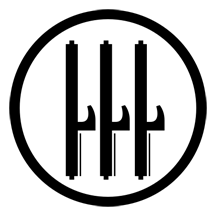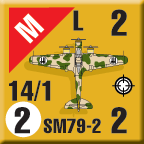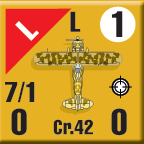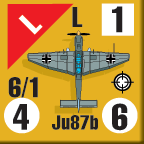| Aircraft
of the Second World War at Sea
Part 4: Italy
By Steve Cabral
July 2013
At the end of World War I the Italian Army
let its air force (Corpo Aeronautico Militare)
wind down, as did many countries. After Mussolini
took power in 1922 the air force found itself
in sympathy with the fascist movement and
became an instrument of propaganda for the
new regime. In 1923 the air force became the
Royal Italian Air Force, Regia Aeronautica,
and a separate and independent force from
the army. All planes and pilots belonged to
the air force, and separate Army and Navy
commands and liaisons were established so
that aircraft assigned to assist those branches
could do so efficiently. In the 1920s and
1930s aviation became quite popular in Italy.
She soon had the third largest airline industry
and more pilots per 1,000 citizens than any
other country. With their low production the
Italians rarely suffered a pilot shortage.
 They
did, however, emphasize training. Stuka and
P.108 crews were given extensive training
before deployment in 1940 and 1941. Training
slipped as the war went on. Stuka pilots were
not able to match the Luftwaffe’s training
of the first Picchiatelli pilots; yet the Italians
developed skip bombing as in U.S. 5th Air
Force. By the start of World War II the Italian
aviators held 96 world records in flight achievements. They
did, however, emphasize training. Stuka and
P.108 crews were given extensive training
before deployment in 1940 and 1941. Training
slipped as the war went on. Stuka pilots were
not able to match the Luftwaffe’s training
of the first Picchiatelli pilots; yet the Italians
developed skip bombing as in U.S. 5th Air
Force. By the start of World War II the Italian
aviators held 96 world records in flight achievements.
Despite sending airplanes to fight in Spain,
the air staff drew many false conclusions
on future air war. Italy became the last country
to adopt a biplane fighter. Her fighters emphasized
maneuverability over speed and armament, while
bombers had the weak armament typical in Europe,
though better than most. In addition, few
Italian planes in 1940 were all metal. Fabric
and wood still figured in construction techniques,
and planes were crafted rather than mass produced.
Her biggest problem was engines. Except for
the Piaggio engines in the P.108, the engine
industry made weak-horsepower models resulting
in low average speed and a need for three
motors in planes that should have mounted
two. None exceeded 1250 hp except the P.108
and those with license-built engines.
Another problem was production. Italy couldn’t
match Japan, let alone France or England.
Total numbers built per model were often 500
to 1,000, and rarely over 200 of the mid-war
designs. Contrast that to 33,000 Bf-109’s
or 11,000 Zeroes. Italy had but 1,200 first-rate
planes in 1940; Germany had 4,900 in September
1939.
After the Italian surrender Mussolini set
up a new government in North Italy called
the RSI. Italian industry along with German
Lend-Lease kept an air force (Aviazione della
RSI) in service until the war ended. In South
Italy a few Italian-built aircraft flew with
the Allies, bolstered by Lend-Lease, such
as P-39Q’s as the Italian Co-Belligerent
Air Force. In June 1946 the Regia Aeronautica
became the Aeronautica Militare with the end
of the monarchy.
Bombers  SM-79:
A three-engined Savoia-Marchetti-produced
bomber with a pronounced hunchback design,
this aircraft served from the Spanish Civil
War to 1944. It composed half of Italy’s
1,000 bombers in 1940. The plane could carry
2,200 lbs of bombs or two 17.7” torpedoes.
It excelled in the torpedo bomber roll and
as a level bomber. It had three heavy and
two light machine guns aboard. Its success
in Spain led to its export to several foreign
countries in a version with twin German engines.
Romania produced these under license. The
replacement, the SM-84, actually had inferior
combat abilities: Fewer than 500 were produced,
and it was retired from service while the
SM-79 remained operational. SM-79:
A three-engined Savoia-Marchetti-produced
bomber with a pronounced hunchback design,
this aircraft served from the Spanish Civil
War to 1944. It composed half of Italy’s
1,000 bombers in 1940. The plane could carry
2,200 lbs of bombs or two 17.7” torpedoes.
It excelled in the torpedo bomber roll and
as a level bomber. It had three heavy and
two light machine guns aboard. Its success
in Spain led to its export to several foreign
countries in a version with twin German engines.
Romania produced these under license. The
replacement, the SM-84, actually had inferior
combat abilities: Fewer than 500 were produced,
and it was retired from service while the
SM-79 remained operational.
SM-81: A three-engined Savoia-Marchetti
bomber developed from an airliner in 1935.
It saw service in Ethiopia and then Spain.
Though it was more aerodynamically shaped
than the SM-79, it had a fixed undercarriage
and retractable turrets that caused it to
be a slow flyer. It carried 1,100 lbs of bombs
but had 10 machine guns aboard, very heavy
by 1930s standards. The aircraft gave good
service but served primarily as a transport
in World War II, though it proved an effective
night bomber in North Africa. Its record against
naval targets was unremarkable.
Z-1007: Entering service in 1938,
this three-engine, all-wood bomber aircraft
from Cantieri Navali Trieste (CANT) proved
a total failure with poor engine performance.
With new engines the plane became the Z1007bis
and gave excellent service from September
1940 onward. It could carry 2,646 lbs of bombs
or two 17.7-inch torpedoes, and carried two
heavy and two light machine guns. The 1943
version could reach 306 mph. Interestingly,
some planes had a single fin and others a
twin tail; they flew side by side without
distinction of tail type. It was the most
graceful looking of the three triple-engined
planes, though its all-wood construction proved
brittle in the extreme conditions of Russia
and North Africa.
Br.20: Fiat’s twin-engine bomber
was designed to trumpet the Fascist powers’
strength. It entered service in Spain in 1937
where it appeared to be a great aircraft.
Japan purchased 100 and found them inadequate
against the Chinese. Redesigned before WW2
as the Br.20M, the newer version served over
the Channel, Greece, North Africa and Russia,
where it excelled at bombing against no opposition
but died in droves if enemy fighters present.
It carried 3,500 lbs of bombs and had four
machine guns.
Ca.309: This twin-engine recon-bomber
with fixed landing gear from Caproni saw little
combat in WW2. It was used primarily as a
transport after the loss of Eritrea and Ethiopia.
It carried 600 lbs of bombs and three machine
guns.
 Ca.313:
Another of the Caproni light bombers (Ca.309-313),
it was designed for colonial service with
a 900 lb bomb load and three machine guns.
It had no outstanding characteristics but
was exported to Sweden. France and Great Britain
ordered 500 of these but only five were delivered.
Germany bought a few as transports. Ca.313:
Another of the Caproni light bombers (Ca.309-313),
it was designed for colonial service with
a 900 lb bomb load and three machine guns.
It had no outstanding characteristics but
was exported to Sweden. France and Great Britain
ordered 500 of these but only five were delivered.
Germany bought a few as transports.
P.108: A four-engined heavy bomber
by Piaggio that looked somewhat like a B-17.
It mounted seven heavy and two light machine
guns. Interestingly it had no tail gun, instead
having twin remote controlled turrets on the
outer engine to cover rear and flanks. Mussolini’s
son Bruno, the 274th Squadron commander, was
killed in a training flight of this bomber
in August 1941. The bomber entered service
in May 1941, but the need to train crews delayed
the operational debut until June 1942. Its
bomb load of 7,000 lbs was heavier than B-17
and lighter than B-24. The aircraft was used
operationally in very small numbers against
targets in Gibraltar and North Africa. The
cargo and airline versions were seized by
the Germans, giving them excellent service
on the Eastern Front.
SM.85: A twin-engined Savoia-Marchetti
dive bomber. After 34 were built the squadron
commander declared that operationally he anticipated
100% casualties. After a few flights the planes
were scrapped and Italy switched to Ju-87B
bombers. It carried an 1,100 lb bomb and had
one machine gun.
Ba.201: Breda produced a single-engine,
single-seat, retractable-gear dive bomber
that could carry an 1,100 lb bomb and was
armed with two heavy machine guns. It had
a remarkable resemblance to a Ju-87 Stuka
except for cockpit and landing gear that looked
like a Hawker Hurricane’s. Only one
was constructed. It had brutally efficient
dive brakes but a low top speed from the German
DB601 engine.
Z-506: A three-engined float plane
by CANT that saw early duty as a bomber and
torpedo plane. It was soon transferred to
recon duties as it proved too vulnerable to
enemy fighters. It could carry 2,600 lbs of
bombs or one torpedo and was armed with three
light and one heavy machine gun. Poland operated
the Z-506 near Danzig in WW2.
Z-501: A large, single-engined CANT
float plane that served from 1935 to 1950.
Though it performed poorly in the face of
enemy fighters it soldiered on in air-sea
rescue and ASW duties. It carried three machine
guns and 1,400 lbs of bombs. It managed to
kill two enemy submarines and damage six.
The plane twice set seaplane endurance records
in the 1930’s.
Ro.37: A single-engine, two-seat
biplane by Industrie Meccaniche Aeronautiche
Meridionali (IMAM). It served as the Italian
army’s primary recon plane in Ethiopia,
Spain and then WW2. It entered service in
1935 and served until 1943. It was extremely
vulnerable to enemy fighters but Italy could
produce nothing better. It carried 400 lbs
of bombs and three machine guns.
Ro.43: A radial-engined floatplane
derived from the R0.37. It served as the primary
shipboard recon aircraft in WW2. It carried
two machine guns and no bombs.
Ro.44: An IMAM single-engine, single-seat
float fighter biplane that entered service
in 1937. It mounted two heavy machine guns.
It was based on the Ro.43, a float variant
of the Ro.37. Its purpose was to provide fleet
fighter cover in the absence of aircraft carriers.
A total failure, it served only in the Aegean,
useless in the face of modern monoplane fighters.
Fighters
Cr.32: A Fiat single-engine biplane fighter that served
from 1932 to 1940. It appeared to give excellent
service in Spain, racking up 300 kills to
73 losses. Italy determined the biplane was
the fighter of the future, but its defeat
of Soviet I-15 biplanes and I-16 monoplanes
was due to superior pilots and tactics. When
encountering Britain’s biplane Gloster
Gladiator in Egypt the Cr.32 was hacked down
in droves. It was quickly retired from operational
service. It was armed with two heavy and two
light machine guns and could carry 220 lbs
of bombs.
 Cr.42:
This Fiat fighter was ordered into production
due to delays in the two new monoplane fighters.
It was the last biplane fighter put in production
by the major powers, and as such is about
the best biplane fighter ever built. It served
from September 1939 to 1949, the Germans converting
many to night intruders. It carried two heavy
machine guns and 440 lbs of bombs. The plane
attained air superiority over the Horn of
Africa but isolation ground them down. They
held their own in North Africa against the
Gladiators but were easily defeated over the
Channel by Spits and Hurricanes. With the
Hurricanes’ arrival in Egypt they switched
to ground support, night fighter, convoy escort
and sea attack modes all with some success. Cr.42:
This Fiat fighter was ordered into production
due to delays in the two new monoplane fighters.
It was the last biplane fighter put in production
by the major powers, and as such is about
the best biplane fighter ever built. It served
from September 1939 to 1949, the Germans converting
many to night intruders. It carried two heavy
machine guns and 440 lbs of bombs. The plane
attained air superiority over the Horn of
Africa but isolation ground them down. They
held their own in North Africa against the
Gladiators but were easily defeated over the
Channel by Spits and Hurricanes. With the
Hurricanes’ arrival in Egypt they switched
to ground support, night fighter, convoy escort
and sea attack modes all with some success.
G.50: Italy’s first monoplane
was very similar to the Mc.200 including the
canopy issue. The Fiat design saw limited
service in Spain and was exported to Finland.
A planned upgrade to G.52 was cancelled in
favor of G.55. Armament and even shape was
similar to the Mc.200.
G.55: Italy’s best fighter
entered service in 1943 with an inline engine
DB605; it was armed with one 20mm and four
heavy machine guns later three cannon and
two machine guns. None fought for the Regia
Aeronautica but did serve with the RSI. It
was produced post-war by Fiat and exported
to Argentina and Egypt. The G.55S had a redesigned
radiator to allow it to carry a single 2,100
lb Whitehead Fiume torpedo.
Mc.200: The Macchi monoplane fighter
armed with two heavy machine guns entered
service in the summer of 1940 escorting SM-79’s
over Malta. Interestingly it was designed
with a closed canopy, but Italian pilots demanded
open ones. They came to regret that in Russia.
It went on to serve until the surrender in
September 1943 when only 100 of 1,100 built
still flew. It could be easily mistaken for
the G.50; the Macchi had a ring of blisters around
the engine cowling making for easy visual
identification.
Mc.202: The Mc.200 was inferior to
contemporary fighters, so a replacement was
made using the wings, controls and part of
the fuselage of that plane mated to a DB601
engine. It was armed with two heavy and two
light machine guns, the later two replaced
by 20 mm guns late in production. The Mc.202
was superior to P-40’s and Hurricanes
and became the main Italian fighter from 1941
onward.
Mc.205: This was a Mc.202 with a
DB605 engine. It served from April 1942 to
1948. It was armed the same as the 202, although
the two lights were sometimes replaced with
two heavy machine guns instead of 20 mm guns.
It was able to stand up to the P-51 and Fw-190
on equal terms.
Re.2000: The Reggiane radial engine
fighter was based on the U.S. Seversky P-35.
It was rejected by the Air Force in favor
of the Mc.200. Testing showed flaws with the
engine (bane of Italy designs) but found it
more maneuverable than the Mc.200 or Bf-109E.
The few planes built were used as fleet escorts
and a catapult version was designed for use on
the new battleships. All were lost in the Fritz-X
attack on the deserting Italian warships in
1943. The land version was withdrawn from
service in 1942. Sweden and Hungary also operated
this aircraft. The Hungarians used a different
engine; the Swedes were stuck with the original.
Armament was two heavy machine guns. 12 long
range versions could carry 4,400 lbs of bombs.
Re.2001: A Re.2000 with a new fuselage,
mounting the inline Alfa Romeo-built DB601,
produced a plane equal to the Mc.202 in performance.
It carried the same armament as the Mc.202
but with longer range. The cannon-armed versions
were used as night fighters. The plane served
over Italy and the Med, and the fighter-bomber
carried a 550 lb bomb. It was in service from
1941 to 1948.
Re.2002: A Re.2001 with a new fuselage
to accommodate a radial engine, it entered
service in 1942. It was armed the same as
Mc.202 though it could mount one 1,100 lb
and two 350 lb bombs, allowing it to serve
as a dive bomber.
Re.2005: A completely new inline
engine fighter mounting three 20 mm and two
heavy machine guns, it entered service in
1943. The 29 built fought over Sicily and
Italy. Germany sent 13 survivors to Romania
for oil field defense. It could carry the
same bomb load as the Re.2002 but hardpoints
were not standard and the plane was very expensive
to produce.
Foreign
Fi-167: This Fieseler torpedo bomber was designed for
use on Graf Zeppelin. Since no carrier materialized
the plane never entered production, and the
12 built were sold to Romania and Croatia.
It was armed with two machine guns and carried
either 2,200lbs of bombs or one torpedo; it
was a two-seat inline-engined biplane.
 Ju-87:
One of the most famous planes of WW2, the
Junkers dive bomber known as the Stuka began
a reign of terror in Spain when Guernica was
bombed and was feared until the Battle of
Britain in 1940. Losses were severe and the
aircraft was withdrawn from France. In Italian
service it began attacks on Malta in August
1940 and continued there through the next
two years with side trips to Greece and North
Africa. The aircraft’s main weakness
was slow speed, which made it an easy target
for enemy fighters. Used overwhelmingly for
ground war, it was capable of doing great
damage against naval targets. Italy purchased
the Ju-87B when their dive bomber designs
proved useless in combat. Armed with two machine
guns and 1,100 lbs of bombs, it was called
Picchiatelli (nose-dive) in Italy. Ju-87:
One of the most famous planes of WW2, the
Junkers dive bomber known as the Stuka began
a reign of terror in Spain when Guernica was
bombed and was feared until the Battle of
Britain in 1940. Losses were severe and the
aircraft was withdrawn from France. In Italian
service it began attacks on Malta in August
1940 and continued there through the next
two years with side trips to Greece and North
Africa. The aircraft’s main weakness
was slow speed, which made it an easy target
for enemy fighters. Used overwhelmingly for
ground war, it was capable of doing great
damage against naval targets. Italy purchased
the Ju-87B when their dive bomber designs
proved useless in combat. Armed with two machine
guns and 1,100 lbs of bombs, it was called
Picchiatelli (nose-dive) in Italy.
Bf-109G: Italy received 305 various
models of the Messerschmitt, including G-6,
G-10, G-12, G-14 and K-4.
Pit
the Allied forces against the Regia Aeronautica
yourself
in Second
World War at Sea: Bomb Alley! |


